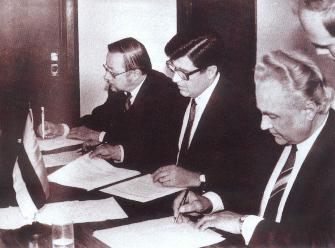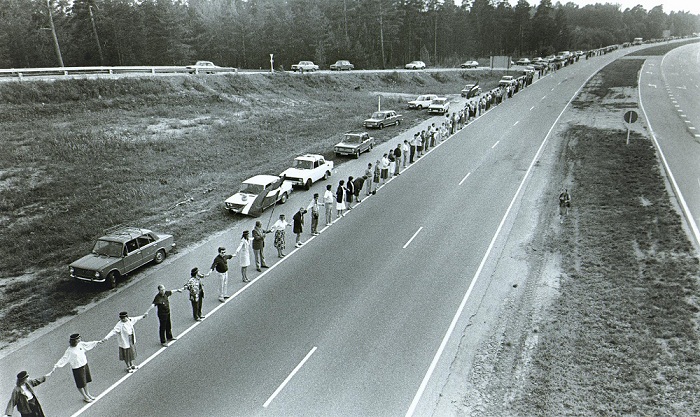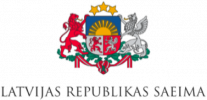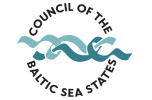Pre-history
Formation of the Baltic States' regional organisations, 1988 - 1991
Along with the beginning of the Awakening in the Baltic States, the Popular Front of Estonia -Rahvarinne, the Popular Front of Latvia - Tautas Fronte, and the reform movement of Lithuania, Sajūdis, began trilateral cooperation to influence processes in the USSR, represent Baltic interests, solve common problems and reach common goals.
Fundamental factors determining Baltic cooperation
The Baltic cooperation and unity reached their culmination at the end of the 1980s and the beginning of the 1990s when the independence movements were acutely aware that the most important goals can be achieved only by close cooperation. Every significant decision and action were mutually harmonised. The heightened sense of regional unity, limited financial and human resources, international circumstances, external threats and pressure, as well as the opportunity to solve specific problems more effectively and reach long-term social and economic goals, were the fundamental factors determining close cooperation among the independence movements.
The Baltic independence movements actively organised regular meetings to discuss and analyse the domestic policy situation, harmonise the establishment and maintenance of contacts with international organisations and Western European countries and formulate a common Baltic position on important issues. The following goals were set to be reached in the near future:
1) Fight for the right of national self-determination and state sovereignty;
2) Restoration and strengthening of the independence of the Baltic States;
3) Gradual demilitarisation of Baltic territories;
4) Economic protection of the Baltic States and the formation of a common Baltic market;
5) Harmonised foreign policy and foreign trade;
6) Formation of a common Baltic information system.

Baltic cooperation institutions
In the period from 1988 to 1991, many initiatives and projects were begun, and their implementation was entrusted to various Baltic cooperation institutions. During the Assembly of the Baltic Independence Movements held on 13 – 14 May 1989 in Tallinn, the Baltic Parliamentary Group was established, and it was given the mandate to coordinate the common position of the Baltic States at the USSR Congress of People’s Deputies in Moscow. Later, in July 1989 in Pärnu, the Baltic Council was formed. It adopted crucial decisions on the Baltic States’ road to independence, such as the Declaration of the Territorial Integrity of the Baltic States, the Appeal to the Nations of the USSR, the Agreement on Common Goals and Cooperation, the Agreement on Further Cooperation Between the Baltic States after the Restoration of Independence, the Appeal Concerning Service in the USSR Army by Young People from the Baltic States, and the Resolution on Victims of Stalinism. The Baltic Council addressed letters to the leading officials of the USSR in which it stated the attitude of the Baltic States towards relations between the Baltic republics and the USSR; joint letters were also sent to the U.S. Senate, the United Nations Commission on Human Rights, etc., explaining the efforts of the Baltic nations to regain their independence and requesting the addressees to help them achieve this goal. The agenda of the Baltic Council included issues on the development of direct economic relations between the Baltic States, Baltic cooperation in harmonising legislation and the concept of Baltic States’ foreign policy. The Baltic Council initiated the Baltic Way on 23 August 1989, when the inhabitants of the Baltic States joined hands from Tallinn to Vilnius and formed a human chain which clearly showed to the international community the common goals and common ideology of the Baltic States and their firm determination to restore national independence and to return to the European family of nations.
Declaration of Unanimity and Cooperation
Baltic cooperation developed quickly, and it involved parliaments and executive powers. In Tallinn on 12 May 1990, Arnold Rüütel, Chairman of the Supreme Council of the Republic of Estonia, Anatolijs Gorbunovs, Chairman of the Supreme Council of the Republic of Latvia, and Vytautas Landsbergis, Chairman of the Supreme Council of the Republic of Lithuania, expressed their determination to strengthen mutual cooperation by signing the Declaration of Unanimity and Cooperation of the Republic of Estonia, the Republic of Latvia and the Republic of Lithuania.

A political event that was of paramount importance in attracting the attention of the international community to the aspirations of the Baltic nations to gain independence was the meeting in Vilnius on 1 December 1990, when deputies of the Estonian, Latvian and Lithuanian Supreme Councils came together for the first time. The Appeal to the Parliaments of the World, which was adopted at this meeting, asked them to use their influence and efforts in forcing the USSR to discontinue its policy of threats and its political, economic and military pressure in relation to the Baltic States; to agree on schedules for the withdrawal of Soviet military troops from the territories of the Baltic States while guaranteeing non-interference by these troops in the affairs of the Baltic States; to eliminate the obstacles preventing Latvia, Lithuania and Estonia from maintaining direct cross-border contact with the rest of the world. The Appeal also contained other significant demands. The independence movements of the Baltic States joined forces to achieve the restoration of independence of the Baltic States.
The cooperation of Estonia, Latvia and Lithuania in the late 1980s and early 1990s is characterised, on the one hand, by an explicit sense of emotional belonging to the Baltic region as evidenced by the Baltic Way of 23 August 1989, joint declarations and statements issued by officials of the Baltic States on Baltic cooperation and unity, and on the other hand, by a pragmatic approach in using regional cooperation because of the limited financial and human resources of Estonia, Latvia and Lithuania, as well as the lack of experience in international politics and in shaping a country’s foreign policy.

Following the Putsch in Moscow in August 1991 and the recognition of independence of the Baltic States on an international level, the issue of developing a Baltic cooperation model was included in the Baltic cooperation agenda. By adopting the experience and traditions of regional cooperation from the Nordic and Benelux countries, the Baltic Assembly was created on 8 November 1991 in Tallinn.
© Photos by Uldis Briedis and Uldis Pāže









